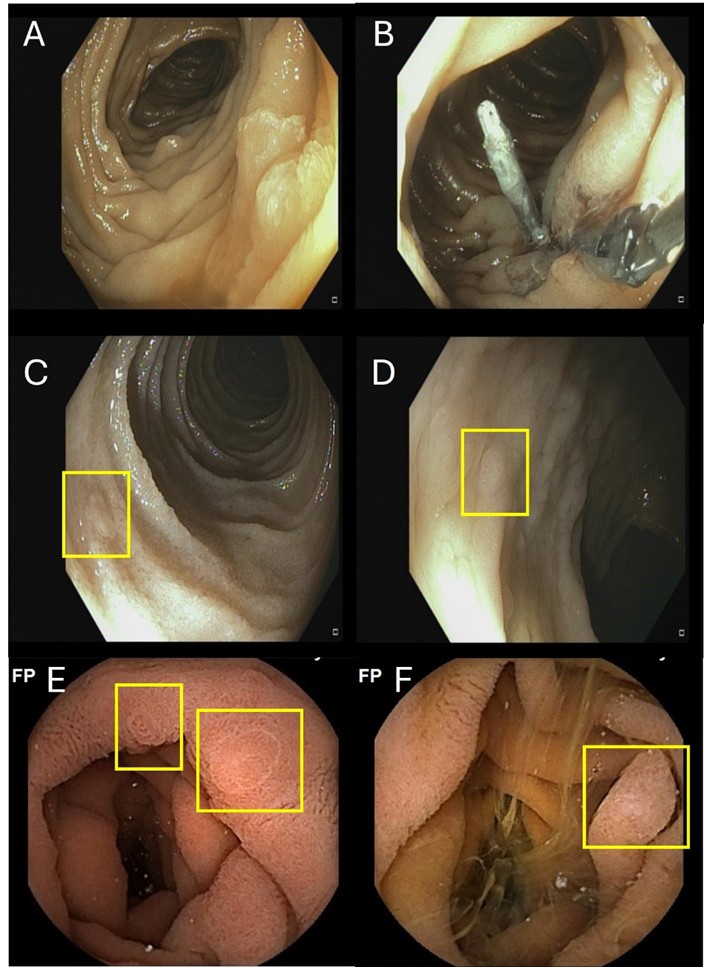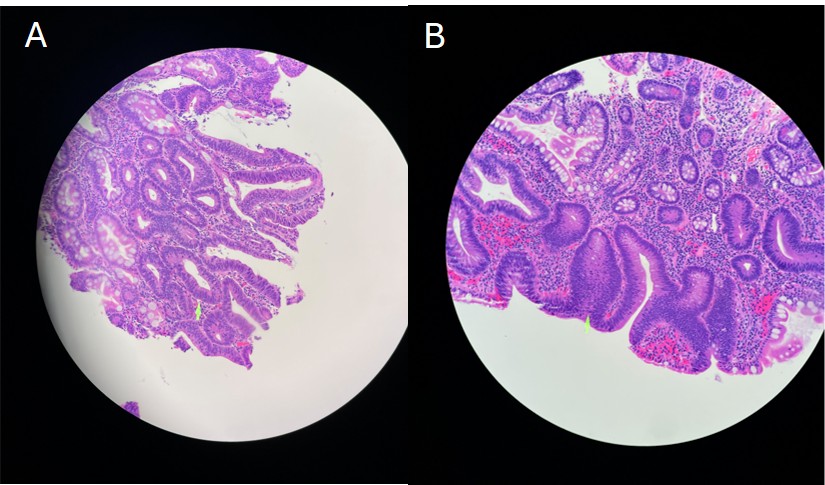Tuesday Poster Session
Category: Small Intestine
P6247 - Small and Important: Jejunal and Ileal Adenomas in a Patient With MUTYH-Associated Polyposis
Tuesday, October 28, 2025
10:30 AM - 4:00 PM PDT
Location: Exhibit Hall

Aanini Dwivedi, MD (she/her/hers)
Temple University Hospital
Philadelphia, PA
Presenting Author(s)
Aanini Dwivedi, MD1, Valeria Martinez-Lebron, MD1, Sara B. Colyer, MD1, Nicholas McDonald, MD2
1Temple University Hospital, Philadelphia, PA; 2Temple University, Philadelphia, PA
Introduction: MUTYH-associated polyposis is a syndrome in which biallelic variants of the MUTYH gene lead to the development of hundreds of colonic adenomas and a significantly increased risk for colorectal cancer. Typically, patients with high polyp burden undergo surgical resection, commonly subtotal colectomy with ileorectal anastomosis. Current consensus guidelines recommend yearly upper endoscopy with push enteroscopy and colonoscopy following surgery to monitor for gastric, duodenal, ampullary, and rectal polyps; however, there is little guidance for surveillance of the jejunum and ileum. In this case, we describe a patient with MUTYH-associated polyposis who was found to have adenomas in the jejunum on push enteroscopy and adenomas in the ileum found on colonoscopy.
Case Description/
Methods: A 34-year-old man with MUTYH-associated polyposis underwent laparoscopic total abdominal colectomy with ileorectal anal anastomosis after he was found to have more than 70 polyps on colonoscopy and enteroscopy. For the next 10 years, he underwent yearly surveillance with enteroscopy and flexible sigmoidoscopy of the rectal stump, with numerous adenomas found over the years.
The primary focus of these endoscopies was surveillance of the stomach, duodenum, and rectal cuff. However, in December 2024, he was found to have a 20 mm sessile polyp in the proximal jejunum on push enteroscopy and was referred for endoscopic mucosal resection. At the time of his follow-up exam, he also underwent colonoscopy, and given the short rectal length, the endoscope was able to be advanced proximally to the middle ileum, where five polyps were found and resected with cold snare. Pathology for the jejunal and ileal polyps revealed tubular adenomas without high grade dysplasia. After multiple small bowel adenomas were found, he underwent video capsule endoscopy in May 2025, demonstrating multiple additional polyps in the proximal and mid-small bowel. Currently, he is scheduled for device assisted enteroscopy for polyp resection.
Discussion: This case highlights that patients with MUTYH- associated polyposis can be at risk for adenomas in the jejunum and ileum. Current guidelines recommend surveillance of the stomach, duodenum, and colon, with limited data for endoscopic surveillance of the jejunum and ileum. Further investigation is needed, as these areas are also potentially at risk for developing adenomas or malignancy in patients with MUTYH-associated polyposis.

Figure: Figure 1: Sessile jejunal polyp depicted in A and after EMR with clips depicted in B. Colonoscopy images with terminal ileum polyps shown in C and D. Video capsule endoscopy image with small bowel polyps shown in E and F.

Figure: Figure 2: Pathology slides depicting the tubular adenoma found in the jejunum (A) as well as one of the tubular adenomas found in the terminal ileum (B).
Disclosures:
Aanini Dwivedi indicated no relevant financial relationships.
Valeria Martinez-Lebron indicated no relevant financial relationships.
Sara Colyer indicated no relevant financial relationships.
Nicholas McDonald indicated no relevant financial relationships.
Aanini Dwivedi, MD1, Valeria Martinez-Lebron, MD1, Sara B. Colyer, MD1, Nicholas McDonald, MD2. P6247 - Small and Important: Jejunal and Ileal Adenomas in a Patient With MUTYH-Associated Polyposis, ACG 2025 Annual Scientific Meeting Abstracts. Phoenix, AZ: American College of Gastroenterology.
1Temple University Hospital, Philadelphia, PA; 2Temple University, Philadelphia, PA
Introduction: MUTYH-associated polyposis is a syndrome in which biallelic variants of the MUTYH gene lead to the development of hundreds of colonic adenomas and a significantly increased risk for colorectal cancer. Typically, patients with high polyp burden undergo surgical resection, commonly subtotal colectomy with ileorectal anastomosis. Current consensus guidelines recommend yearly upper endoscopy with push enteroscopy and colonoscopy following surgery to monitor for gastric, duodenal, ampullary, and rectal polyps; however, there is little guidance for surveillance of the jejunum and ileum. In this case, we describe a patient with MUTYH-associated polyposis who was found to have adenomas in the jejunum on push enteroscopy and adenomas in the ileum found on colonoscopy.
Case Description/
Methods: A 34-year-old man with MUTYH-associated polyposis underwent laparoscopic total abdominal colectomy with ileorectal anal anastomosis after he was found to have more than 70 polyps on colonoscopy and enteroscopy. For the next 10 years, he underwent yearly surveillance with enteroscopy and flexible sigmoidoscopy of the rectal stump, with numerous adenomas found over the years.
The primary focus of these endoscopies was surveillance of the stomach, duodenum, and rectal cuff. However, in December 2024, he was found to have a 20 mm sessile polyp in the proximal jejunum on push enteroscopy and was referred for endoscopic mucosal resection. At the time of his follow-up exam, he also underwent colonoscopy, and given the short rectal length, the endoscope was able to be advanced proximally to the middle ileum, where five polyps were found and resected with cold snare. Pathology for the jejunal and ileal polyps revealed tubular adenomas without high grade dysplasia. After multiple small bowel adenomas were found, he underwent video capsule endoscopy in May 2025, demonstrating multiple additional polyps in the proximal and mid-small bowel. Currently, he is scheduled for device assisted enteroscopy for polyp resection.
Discussion: This case highlights that patients with MUTYH- associated polyposis can be at risk for adenomas in the jejunum and ileum. Current guidelines recommend surveillance of the stomach, duodenum, and colon, with limited data for endoscopic surveillance of the jejunum and ileum. Further investigation is needed, as these areas are also potentially at risk for developing adenomas or malignancy in patients with MUTYH-associated polyposis.

Figure: Figure 1: Sessile jejunal polyp depicted in A and after EMR with clips depicted in B. Colonoscopy images with terminal ileum polyps shown in C and D. Video capsule endoscopy image with small bowel polyps shown in E and F.

Figure: Figure 2: Pathology slides depicting the tubular adenoma found in the jejunum (A) as well as one of the tubular adenomas found in the terminal ileum (B).
Disclosures:
Aanini Dwivedi indicated no relevant financial relationships.
Valeria Martinez-Lebron indicated no relevant financial relationships.
Sara Colyer indicated no relevant financial relationships.
Nicholas McDonald indicated no relevant financial relationships.
Aanini Dwivedi, MD1, Valeria Martinez-Lebron, MD1, Sara B. Colyer, MD1, Nicholas McDonald, MD2. P6247 - Small and Important: Jejunal and Ileal Adenomas in a Patient With MUTYH-Associated Polyposis, ACG 2025 Annual Scientific Meeting Abstracts. Phoenix, AZ: American College of Gastroenterology.
